A Defining American Value: Education in 21st Century America
This is the text of Pitt Chancellor Mark A. Nordenberg’s American Experience Distinguished Lecture, delivered March 24 at Pitt’s University Club. The lecture series is cosponsored by the University Honors College and by the Dick Thornburgh Forum for Law and Public Policy.
The Pulitzer prize-winning journalist Ellen Goodman once said, “If there is a single message passed down from each generation of American parents to their children, it is a two-word line: Better yourself. And if there is a temple of self-betterment in each town, it is the local school. We have worshiped there for sometime.”
The people of Pitt—regularly gathering in, or in the shadow of, the Cathedral of Learning—are familiar with the use of religious imagery to further elevate an already noble mission. Though initially uncomfortable with its name, Chancellor John Bowman, who drove the Cathedral’s construction, came to appreciate the inspirational appeal of that label. In seeking support during the depths of the Great Depression, he described the project in ways that were both physical and spiritual:
A building . . . to rise 500 feet or more above the grass; to rise and to express . . . the heart and soul of education. Courage and spirituality—stones could be made to express such values of character. Parallel lines going up and up—they would express courage, fearlessness. . . . [The building] would tell Pittsburgh every day of these values. It would unify Pittsburgh into a community conscious of its character.
At the building’s 1937 dedication, he further advanced those themes, saying: “They shall find wisdom here, and faith. In steel and stone, in character and thought, they shall find beauty, adventure, and moments of high victory.”
The words of Ellen Goodman, though uttered not so long ago, seem quite out-of-date in 2014. To be sure, the idealized “temples of self-betterment” described in the Goodman quote have not disappeared entirely from the American scene and, in fact, are thriving, in more modern form, in some communities. Sadly, however, general perceptions of basic education have come to be shaped by what many fear is the “new normal” in too many places: a lack of discipline, violence, truancy, declines in achievement and rates of graduation, and levels of student attainment that do not fare well when measured against global competition.
American higher education, 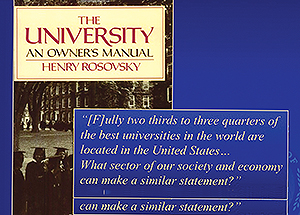 on the other hand, remains the envy of the world. In a book published in 1990, Henry Rosovsky, Harvard’s long-time dean of arts and sciences, wrote:
on the other hand, remains the envy of the world. In a book published in 1990, Henry Rosovsky, Harvard’s long-time dean of arts and sciences, wrote:
[F]ully two thirds to three quarters of the best universities in the world are located in the United States. . . . What sector of our society and economy can make a similar statement? One can think of baseball, football, and basketball teams, but that pretty much exhausts the list. . . . It has been suggested to me that we are home to a similar proportion of the world’s leading hospitals. Since most of these are part of university medical schools, my point is only reinforced.
Since those words were published, some change in international rankings has occurred, as countries abroad have worked hard to develop universities like those that call America home. But to date, that change has been limited—except for the growing number of such rankings and the rise of Pitt within them.
Just last week, a new set of global rankings, based on the quality and quantity of scholarly publications, crossed my desk. Its methodology, which is somewhat less favorable to U.S. universities overall than others produced abroad, nonetheless lists seven U.S. universities among the world’s top 10, 17 among its top 25, and 27 among its top 50. In this study, Pitt had a global ranking of 22. Remembering that this is a ranking that involves all of the universities in the world, this is a very strong showing—by our University and by the universities of our country. (Story on page 1.)
But real pressures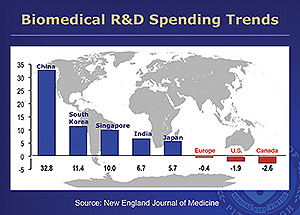 do exist, and they are grounded both in heightened international competition and declining national and state financial support. Consider as one point of reference this chart showing comparative growth rates of biomedical research and development spending over the five-year period from 2007 to 2012. (See chart on right.) Investments in major Asian countries, led by China, are markedly up, while spending in Europe, the U.S., and Canada actually declined.
do exist, and they are grounded both in heightened international competition and declining national and state financial support. Consider as one point of reference this chart showing comparative growth rates of biomedical research and development spending over the five-year period from 2007 to 2012. (See chart on right.) Investments in major Asian countries, led by China, are markedly up, while spending in Europe, the U.S., and Canada actually declined.
That global trend should be of interest to all Americans. However, given the importance of biomedical research to the economy of this region, it is a cause for particular concern here in Pittsburgh. To be sure, the explanations for any single chart can be varied. In this case, for example, the U.S. started with a larger base and growth trends may have become skewed as we dealt with the recent challenges of the Great Recession.
However, my deepest worry is that these charted changes are rooted in possible new attitudes—among the public and its elected representatives. If my concerns are well founded, this is a retreat from attitudes that made this country great—a change that focuses on the present at the expense of the future and that diminishes the priority assigned to both higher education and research, to the detriment of coming generations. Let me share some modern American context.
Higher Education and Research in Post-World War II America
As World War II drew to a close, it was estimated that 15 million service men and women soon would be returning to civilian life. This created the possibility of a post-war depression, with high levels of unemployment. In response, the National Resources Planning Board recommended a program to help veterans adjust to civilian life—the Serviceman’s Readjustment Act of 1944, which came to be known more commonly as the GI Bill.
That act provided federal assistance in other areas but had a special focus on education. In the next seven years, eight million veterans received some educational benefits, and 2.3 million of them attended colleges and universities. As a result, the number of degrees awarded by American colleges and universities more than doubled between 1940 and 1950.
Among the well-known figures who advanced their educations using the GI Bill were Presidents Gerald Ford and George Herbert Walker Bush; Supreme Court Justices William Rehnquist, John Paul Stevens, and Byron White; and Senators Bob Dole, John Glenn, George Mitchell, and Daniel Patrick Moynihan. Clearly, the country received a handsome return on the investments it made in those veterans. And they were joined by millions of others, who received for their service the greatest gift that could be given by their country—the life-transforming power of higher education.
In the late 1950s,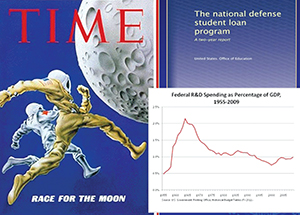 following the Soviet Union’s launch of Sputnik, which was said to have shattered the sense of comfort in America’s scientific prowess, the National Defense Education Act was passed. In addition to providing direct forms of institutional support, it created the National Defense Student Loan Program. As had been true with the GI Bill, this act was grounded in a belief that significant investments in education not only were beneficial to the individual recipients of the support but were critical investments in our national security.
following the Soviet Union’s launch of Sputnik, which was said to have shattered the sense of comfort in America’s scientific prowess, the National Defense Education Act was passed. In addition to providing direct forms of institutional support, it created the National Defense Student Loan Program. As had been true with the GI Bill, this act was grounded in a belief that significant investments in education not only were beneficial to the individual recipients of the support but were critical investments in our national security.
In the case of the GI Bill, the threat was economic, a post-war depression. The National Defense Education Act was driven by “Cold War” fears that national security was being threatened by scientific advances in the Soviet Union. Those fears also influenced dramatic increases in federal research spending in that same general time period.
Shifting to Pennsylvania, three key developments, from the early to mid-1960s, underscored our home state’s strong commitment, at that time, to investments in higher education. They were: the creation of the Pennsylvania Higher Education Assistance Agency; the creation of the state’s community college system; and the transformation of Pitt and Temple, which had been private, to public, state-related universities.
There is a link between the GI Bill and these higher education developments in Pennsylvania. Not only did the country experience a post-war “baby boom” but that boom was born of parents who placed a far higher value on higher education, at least in part because of their own experiences with the GI Bill. As noted, elected officials responded with actions supporting the aspirations of those parents and their children. And in the minds of some, there was a basic obligation to do so.
The late K. Leroy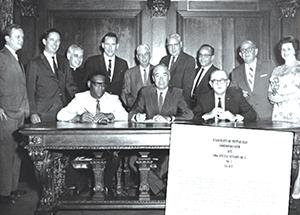 Irvis, a graduate of our Law School who later served as the first African-American Speaker of the Pennsylvania House of Representatives and was a long-time Pitt Trustee, was an advocate for each of these three pieces of legislation. In making his case, he expressed the belief that “everyone should have a right to a state-supported college education,” and said he found it “amazing to say we have an obligation to pay for education through the 12th grade and then there’s a magic cutoff.” He further observed that for too long Pennsylvania had been “nearly last in its efforts in the field of Education,” along with the hope that “the Commonwealth will soon take its rightful place as a leader in the field of Education among the 50 states.”
Irvis, a graduate of our Law School who later served as the first African-American Speaker of the Pennsylvania House of Representatives and was a long-time Pitt Trustee, was an advocate for each of these three pieces of legislation. In making his case, he expressed the belief that “everyone should have a right to a state-supported college education,” and said he found it “amazing to say we have an obligation to pay for education through the 12th grade and then there’s a magic cutoff.” He further observed that for too long Pennsylvania had been “nearly last in its efforts in the field of Education,” along with the hope that “the Commonwealth will soon take its rightful place as a leader in the field of Education among the 50 states.”
In terms of Pitt’s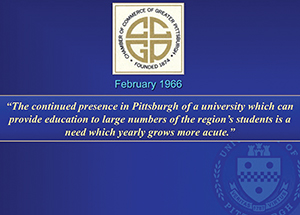 conversion into a public university, business leaders expressed the view that, beyond reduced tuition, there would be broader community benefits. This position was captured in a resolution unanimously adopted by Pittsburgh’s Chamber of Commerce in February of 1966. It said:
conversion into a public university, business leaders expressed the view that, beyond reduced tuition, there would be broader community benefits. This position was captured in a resolution unanimously adopted by Pittsburgh’s Chamber of Commerce in February of 1966. It said:
The continued presence in Pittsburgh of a university which can provide education to large numbers of the region’s students is a need which yearly grows more acute.
As industry becomes more complex, our region will require a continuous supply of educated manpower. In the past decade, Pitt has taken giant strides toward becoming a great university. It has built up its faculty and expanded its curriculum. The Chamber supports efforts to solidify and continue these programs.
We are all familiar with the impetus that outstanding educational complexes have given [to] cultural and economic growth in other sections of the country. We have similar educational resources in Pittsburgh and wish to maintain and expand them.
To underscore a basic point, this Chamber resolution extends beyond tuition subsidies for Pitt students, as important as that obviously has been. It also prioritizes support for what might be called a key “anchor institution,” one that, through the breadth of its programs, contributes to community vitality and regional economic growth.
The Rise of the “Eds and Meds”
It is impossible not to wonder about the prescience of those who drafted that resolution in the days when steel was still king and corporations like Gulf, Rockwell, Alcoa, and the original Westinghouse still called Pittsburgh home. It is hard to know what led those resolution drafters to see that a different kind of economic anchor might be required, but today, we know that did become the case.
In fact, Pittsburgh’s economy hit rock-bottom just over thirty years ago—when regional unemployment topped 18 percent. Today, in contrast, the Pittsburgh region frequently is touted—even by authorities rarely in agreement on other matters, such as Presidents George W. Bush and Barack Obama—as a model of 21st century economic transformation.
Our regional economy today is more diverse—with strengths in such areas as advanced manufacturing, energy, financial services and professional services. However, after “the bottom fell out,” it was the so-called “eds and meds” that stepped up to really fill the gap, particularly with respect to employment. What has been labeled the education and health services “super-sector” by the U.S. Department of Labor now accounts for more than one-fifth of the region’s total employment and is the only sector that has added jobs every year since 1995.
In commenting on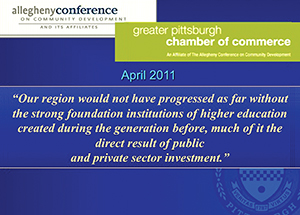 these trends, the Allegheny Conference on Community Development, the parent of the Greater Pittsburgh Chamber of Commerce, which had advocated for university support in the mid-1960s, more recently said:
these trends, the Allegheny Conference on Community Development, the parent of the Greater Pittsburgh Chamber of Commerce, which had advocated for university support in the mid-1960s, more recently said:
Pittsburgh has attracted global attention in recent years for its economic transformation
. . . . [w]e diversified our economy by creating entire new industries in health care & life sciences and information & communications technology, while retaining our strengths in advanced manufacturing, finance and energy.
Our region would not have progressed as far without the strong foundation institutions of higher education created during the generation before, much of it the direct result of public and private sector investment. Much of our success in building the life sciences sector over the past two decades would have been impossible without university leadership and success in recruiting globally-leading faculty who in turn attract hundreds of millions of research dollars to our region every year. The Commonwealth cannot afford to lose these individuals and the intellectual capital and innovative spin-offs they are creating.
Putting Progress at Risk
Unfortunately, we are headed in the direction of lasting losses—to our country, to the Commonwealth, and to our home community—and well-reasoned warnings are coming from multiple directions. For example, in the summer of 2012, the National Research Council released a Congressionally requested report entitled Research Universities and the Future of America. That report was written by a blue-ribbon committee chaired by the former CEO of DuPont. This is how it begins:
America is driven by innovation—advances in ideas, products, and processes that create new industries and jobs, contribute to the nation’s health and security and support a high standard of living. In the past half-century, innovation itself has been increasingly driven by educated people and the knowledge they produce. Our nation’s primary source of both new knowledge and graduates with advanced skills continues to be our research universities.
However, these institutions now face an array of challenges, from unstable revenue streams and antiquated policies and practices to increasing competition from universities abroad. It is essential that we as a nation reaffirm and revitalize the unique partnership that has long existed among research universities, the federal government, the states, and philanthropy and strengthen its links with business and industry. In doing so, we will encourage the innovation that leads to high-quality jobs, increased incomes and security, health and prosperity for our nation.
In the very next paragraph, the report refers to research universities as “a major national asset—perhaps even its most potent one.” The authors then go on to list some specific advances that can be attributed to this potent national asset. “Lasers, radar, synthetic insulin, blood thinners, magnetic resonance imaging, computers and rocket fuel are among the countless innovations in which university research has played an essential role.” That list has a proud local tone to it, since Paul Lauterbur, a Pitt graduate, won the Nobel Prize in Medicine for his fundamental contributions to the science of magnetic resonance imaging, work that began while he was a graduate student here, and Pitt Professor Panayotis Katsoyannis was the first to synthesize insulin and did so in his University lab on this campus.
Just a few months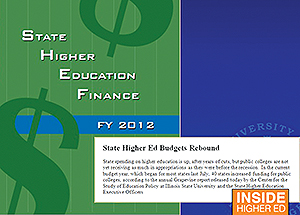 after the National Research Council report was released, the Pennsylvania Governor’s Advisory Commission on Post-Secondary Education published its own report and sounded companion warnings. It stated that “Pennsylvania’s higher education funding has declined over 20 percent in nominal dollars [that is, in absolute dollars unadjusted for inflation] from its FY08/09 peak” and warned that “this level of funding impacts both the affordability of postsecondary education for families in the Commonwealth and the ability of institutions to maintain high levels of quality while advancing their missions.” It further asserted that “it is imperative to the health and vitality of our postsecondary education system that funding not fall” further and noted the special role played by research universities in economic growth.
after the National Research Council report was released, the Pennsylvania Governor’s Advisory Commission on Post-Secondary Education published its own report and sounded companion warnings. It stated that “Pennsylvania’s higher education funding has declined over 20 percent in nominal dollars [that is, in absolute dollars unadjusted for inflation] from its FY08/09 peak” and warned that “this level of funding impacts both the affordability of postsecondary education for families in the Commonwealth and the ability of institutions to maintain high levels of quality while advancing their missions.” It further asserted that “it is imperative to the health and vitality of our postsecondary education system that funding not fall” further and noted the special role played by research universities in economic growth.
So where do we stand in terms of state funding? To be clear, the record of lagging support for higher education in Pennsylvania is a long one. In the past dozen years, for example, Pitt experienced five difficult and disruptive mid-year appropriations cuts. However, things turned markedly worse three years ago, when the budget proposed would have cut our general appropriation by 50 percent and completely eliminated our academic medical support. That would have been a major step toward the elimination of public higher education as we know it.
Though the recommended reductions ultimately were tempered, largely because of the support of sympathetic legislators, our general appropriation was cut by 19 percent; our academic medical support was cut by 50 percent; and our capital projects support was cut by 50 percent. In that single year, then, Pitt suffered cuts to its state support that totaled $67 million.
For the past two years, our state funding has been flat, and that is what has been proposed for this year as well. We understand, of course, that these continue to be challenging times, and we always have been prepared to do our fair share. However, a year of historically deep and disproportionate cuts followed by two years of flat funding have taken Pitt back to the levels of state support received in 1995—again in nominal dollars, unadjusted for inflation. With inflationary adjustments, Pitt now receives lower levels of support than at any time since it was made a public university in the mid-1960s.
Just as important,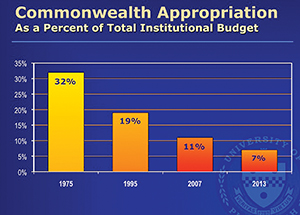 are the discouraging trend-lines. (See chart on right.) A report released just last month indicated that, with economic pressures from the Great Recession easing, all but 10 states had increased their investments in higher education last year. Unfortunately, Pennsylvania was one of the 10 that did not. So, despite the hopes expressed by Speaker Irvis nearly a half-century ago that Pennsylvania might finally move into a position of leadership, we now rank 47th among the 50 states in our investments in higher education, whether measured on a per capita basis or employing an income-adjusted standard.
are the discouraging trend-lines. (See chart on right.) A report released just last month indicated that, with economic pressures from the Great Recession easing, all but 10 states had increased their investments in higher education last year. Unfortunately, Pennsylvania was one of the 10 that did not. So, despite the hopes expressed by Speaker Irvis nearly a half-century ago that Pennsylvania might finally move into a position of leadership, we now rank 47th among the 50 states in our investments in higher education, whether measured on a per capita basis or employing an income-adjusted standard.
But as the 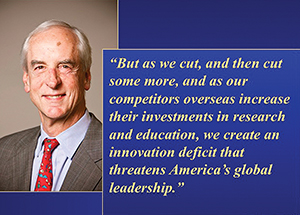 National Research Council report makes clear, dramatic reductions in state support are just one part of the problem. On the federal front, the most highly publicized reductions to research support came through what has been called “the blunt and reckless tool” of sequestration. But challenges on the national front also have been more broad and extended. To take one funding source that is particularly important to both the cause of human health and the strength of the Pittsburgh economy, the National Institutes of Health saw a 20 percent reduction in the purchasing power of its grants from 2003 to 2013. The situation was broadly described by Hunter Rawlings, the president of the Association of American Universities, in the following way:
National Research Council report makes clear, dramatic reductions in state support are just one part of the problem. On the federal front, the most highly publicized reductions to research support came through what has been called “the blunt and reckless tool” of sequestration. But challenges on the national front also have been more broad and extended. To take one funding source that is particularly important to both the cause of human health and the strength of the Pittsburgh economy, the National Institutes of Health saw a 20 percent reduction in the purchasing power of its grants from 2003 to 2013. The situation was broadly described by Hunter Rawlings, the president of the Association of American Universities, in the following way:
For seven decades, federally funded university research has produced innovations that have driven the economy, dramatically improved health, and enhanced national security. This research has also made possible the training of generations of American scientists and engineers. But as we cut, and then cut some more, and as our competitors overseas increase their investments in research and education, we create an innovation deficit that threatens America’s global leadership.
Education as an Endangered Priority
American settlers understood the critical role of education from the very earliest of colonial times. We see that in the founding of such outstanding institutions as Harvard in 1636, William and Mary in 1693, Yale in 1701, Penn in 1740, Princeton in 1746, and Columbia in 1754. We also see it in the founding of our own university, not much later—on February 28, 1787, a few months before a new constitution breathed life into a new country, the United States of America. At that time, the frontier town of Pittsburgh literally sat at the edge of the American wilderness, and when its people talked about survival, they meant it in the literal sense.
Still, our pioneering predecessors made education a high priority. Our founder, Hugh Henry Brackenridge, explained that future-oriented choice by saying: “We well know the strength of a state greatly consists in the superior mental powers of the inhabitants.” And the preamble to our chartering legislation, which he sponsored, begins with the simple declaration that “the education of youth ought to be a primary object with every government.”
In recent years, we have seen a retreat from the responsibility to keep this priority strong in both Washington and Harrisburg. With rare exceptions, this is not the product of hostility to universities or their work. Instead, it is the product of tough economic times and a set of embedded funding commitments, some tied to underfunded pensions and entitlements, that essentially are transferring wealth from the young to the old, reversing the trend that has long been felt to be characteristic of this country.
During the height of the budgetary debates of recent years, it was not at all uncommon for elected officials to invoke the example of the family that had to live within its means and to say, not unfairly, that government had to learn to do the same. But the comparison almost always ended at that point, without encompassing the even more telling aspects of the analogy—the values that shape family priorities and the parental struggles to advance those priorities once they have been set.
The families whose approaches to life we have most honored are those in which the highest parental goal is helping to build the foundation for better lives for their daughters and sons—their next generation. We always have celebrated, in particular, the efforts of parents who sacrifice spending on themselves, or who find ways to generate more income by taking on additional work, to provide their children with a quality education. Put another way, I doubt that we could find a single example of a family being lauded for living within its means by sacrificing the needs of its children or their futures.
Today, the application of the family analogy to governmental budgets rarely seems to reach that second stage. Elected officials do regularly say that we cannot, in good conscience, leave our children and grandchildren to deal with the crushing government debt that continues to grow, and it would be hard for anyone to disagree with that. But comparatively little attention is paid to the crushing personal debts that may be incurred by many members of our society’s next generation if public support for higher education is further slashed. And the society to be occupied by our children and grandchildren will be less well-equipped to contend with the challenges of the world in which they live if higher education has moved beyond the means of many.
And, then, there are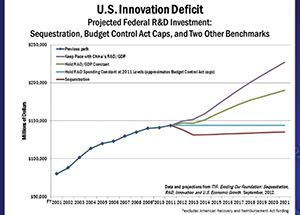 the broader lessons of modern American history. In the aftermath of World War II, we faced the prospect of another depression. We avoided it by investing in education as the key to building an even stronger economy. In the 1960s, our country was driven by a Cold War fear of Soviet scientific superiority and how that might undermine national security. We reclaimed our place of global superiority by investing in education and research. Today, we face an innovation deficit that could be every bit as crippling, both in terms of the economy and national security, but we seem incapable of responding in a similarly decisive and well-targeted way and, instead, continue to drift in troublesome directions.
the broader lessons of modern American history. In the aftermath of World War II, we faced the prospect of another depression. We avoided it by investing in education as the key to building an even stronger economy. In the 1960s, our country was driven by a Cold War fear of Soviet scientific superiority and how that might undermine national security. We reclaimed our place of global superiority by investing in education and research. Today, we face an innovation deficit that could be every bit as crippling, both in terms of the economy and national security, but we seem incapable of responding in a similarly decisive and well-targeted way and, instead, continue to drift in troublesome directions.
To be clear, this does not mean that America’s colleges and universities have no role to play in reforming themselves to better deal with these issues. In fact, the major reports that I have cited—both the National Research Council report and the report of the Governor’s Advisory Commission on Postsecondary Education—include sections calling on higher education institutions to work to become more affordable and more accountable.
Passing on What We Have Been Given
In the end, though,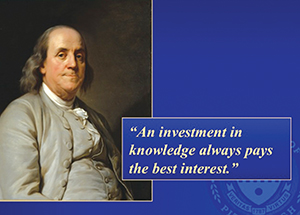 the priorities set in Washington and Harrisburg will largely chart the course to be followed by our country, our Commonwealth, and our home communities. And in thinking about what those priorities should be, I find myself returning to the words of Benjamin Franklin—perhaps the greatest Pennsylvanian and certainly one of the greatest Americans. This is what he said: “An investment in knowledge always pays the best interest.”
the priorities set in Washington and Harrisburg will largely chart the course to be followed by our country, our Commonwealth, and our home communities. And in thinking about what those priorities should be, I find myself returning to the words of Benjamin Franklin—perhaps the greatest Pennsylvanian and certainly one of the greatest Americans. This is what he said: “An investment in knowledge always pays the best interest.”
Mr. Franklin did not say that investing in knowledge, or anything else, would be painless. In fact, we all know that making choices and advancing priorities invariably involves some measure of pain. We also know that the rewards of working through that pain can be a source of deep satisfaction when the full promise of a worthy priority is realized.
Most of us have seen that in our own lives. We also have seen it in our collective progress. Hopefully, in the years ahead, succeeding generations of Americans and Pennsylvanians will have the opportunity to look back and applaud this society’s re-commitment to education and research, gratefully acknowledging all of the good that resulted— in terms of strong national security, in terms of a growing economy, in terms of advancements in human health, and in terms of countless lives made richer and more productive.
Higher education has long been viewed as key to the American dream. And having been given that key ourselves, we owe it to succeeding generations to do everything we can to similarly position them to successfully pursue that dream, for themselves and for their country. In thinking about the ways in which we might help create an even better world, this is a priority worth pursuing together.
Other Stories From This Issue
On the Freedom Road

Follow a group of Pitt students on the Returning to the Roots of Civil Rights bus tour, a nine-day, 2,300-mile journey crisscrossing five states.
Day 1: The Awakening
Day 2: Deep Impressions
Day 3: Music, Montgomery, and More
Day 4: Looking Back, Looking Forward
Day 5: Learning to Remember
Day 6: The Mountaintop
Day 7: Slavery and Beyond
Day 8: Lessons to Bring Home
Day 9: Final Lessons

